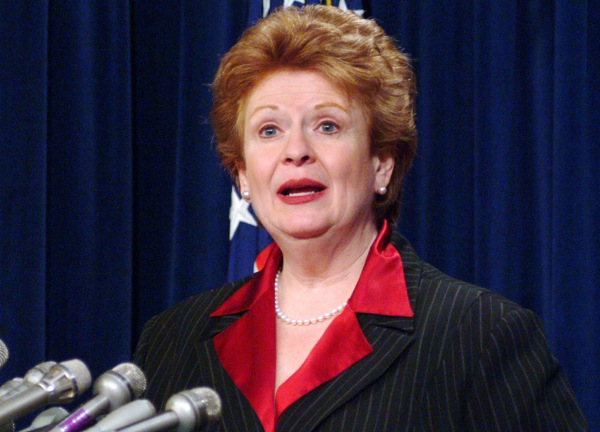A Political Game of ‘Win the Docs’
Democrats are in the uncomfortable position of claiming that an overhaul of the way doctors are paid under Medicare is somehow not part of health care reform.
Jul 31, 2020241.6K Shares3.5M Views
Sen. Debbie Stabenow (D-Mich.) (WDCpix)
With the nation’s insurers having droppedtheir support for the health reforms moving through Congress, Senate Democrats are taking daring steps to rally the backing of another powerful medical lobby: doctors.
The Senate this week is set to take up a $245 billion proposal, introduced hastily just a week ago by Sen. Debbie Stabenow (D-Mich.), to prevent scheduled pay cuts for doctors who treat Medicare patients – a long-term fix to the physician pay quandary that dwarfs the one-year patch contained in the Senate Finance Committee’s reform bill. The proposal has long been advocated by the American Medical Association, the nation’s largest physicians lobby, which has so far declinedto endorse the broader Senate health bill. Although the group is also fighting Democrats over malpractice reform, the Stabenow bill would go a long way toward getting the doctors to support the top domestic priority of the Obama administration this year.
Illustration by: Matt Mahurin
Despite the allure of getting the AMA on board, however, the Democrats’ move is not without its pitfalls. For months, party leaders in Congress and the White House have vowed to keep the cost of health reform below $900 billion over 10 years, while also promisingthat the legislation won’t add “one dime” to the nation’s debt. The Stabenow bill, however, is not paid for, leaving Democrats in the uncomfortable position of claiming that a complete overhaul of the way doctors are paid under Medicare is somehow not a part of health care reform. That pickle has created an urgency: the faster Democrats can pass the physician pay measure, the better chance they have of distancing it from the broader reform effort.
Robert Blendon, professor of health policy at Harvard University, said the Democrats’ success in forging that divide likely “depends on the visibility of the issue.”
“So much attention is on putting the [Finance and HELP committee health reform] bills together that this could go under the radar,” said Blendon, an expert on the Clinton administration’s failed attempt to pass comprehensive health care reform in 1993. “[But] if it gets a lot of media attention, it’s going to be clear to anyone who reads the story that the additional $250 billion is in fact related to health reform.”
At issue is the so-called sustainable growth rate(SGR), a complex, 12-year-old formula designed to prevent Medicare doctor payments from bankrupting the program by indexing reimbursements to the growth of the economy. Because health care inflation has risen much faster than GDP in recent years, the SGR has called for physician cuts every year since 2002. Congress, however, has usually stepped inwith temporary patches to prevent those cuts, which the AMA says would force doctors to drop Medicare patients.
Years of kicking the can down the road, though, has caused the cuts to compound. Indeed, next year, the SGR calls for a 21.5 percent reduction in physicians’ Medicare payments, with an additional 5.5 percent cut in each of the four years thereafter. The Finance bill provides roughly $11 billion to address 2010, but lends no long-term relief — a dance that sidesteps one of the most sensitive and expensive problems facing the entire health delivery system.
Enter the Stabenow bill — all 18 lines long — which scraps the SGR altogether, erases the accumulated cuts and provides a 0 percent pay update “for 2010 and each subsequent year.” That means in perpetuity. The idea is to have the broader health reform bill complement Stabenow’s proposal by creating a new physician payment formula that better reflects the true costs of treating Medicare patients.
Calls to AMA were not returned, but the group has launched an enormous ad campaignin support of the strategy.
That this fix costs roughly a quarter of a trillion dollars hasn’t dissuaded Democratic leaders. Instead they’re hoping that, by considering the doc-fix bill on a separate track, they can divorce it from the broader issue of health reform. Last Friday, Sen. Tom Harkin (D-Iowa), chairman of the Health, Education, Labor and Pensions Committee, told reporters just that.
“We’re doing the doc fix first so as not to get it confused with health care reform,” Harkin said. “We’re going to try to pass it as an emergency-type of spending so that it doesn’t … connect to the health care reform bill and figure in as a cost of it.”
Republicans, though, aren’t buying it. Although they acknowledge that the SGR is seriously flawed, they also want to cover the costs of fixing it. Sen. Charles Grassley (Iowa), the senior Republican on the finance panel, toldThe New York Times last week that Stabenow’s bill “undermines the president’s commitment to making sure health care reform won’t add a dime to the deficit when one of the most expensive problems in the Medicare program is removed from overall reform legislation.”
Republicans are not alone. Moderate Democrats are also criticizing the proposal for lacking offsets. Sens. Kent Conrad (N.D.) and Evan Bayh (Ind.), for example, have already indicatedthat they plan to vote against the measure. And in the House, Speaker Nancy Pelosi (D-Calif.) last week reiteratedher previous vowto support an SGR fix this year only if the bill is accompanied by pay-as-you-go rules.
The criticisms haven’t been lost on Senate Democratic leaders. Last Thursday, Senate Majority Leader Harry Reid (D-Nev.) scheduleda Monday cloture vote on the Stabenow bill, only to scrap that plan a day laterfor lack of support. GOP leaders, meanwhile, want to amend the bill by attaching offsets as well as provisions addressing medical malpractice reform.
The stalemate over the SGR fix comes as no surprise to health policy experts. “People have known for many, many years that this was a screwed up policy – that it doesn’t work at all,” said Leighton Ku, public health policy professor at George Washington University. The sticking point has not been whether to fix it, Ku added, but how to pay for it.
That the Democrats have chosen not to offset the Stabenow proposal means the bill likely won’t pass the Senate, according to Julius Hobson, former AMA lobbyist and now a senior policy analyst at the Washington law firm Bryan Cave. Hobson said the bill should get plenty of floor time, but probably won’t get the 60 votes likely needed to waive the Budget Act — a vote required to allow the unfunded proposal to proceed.
Asked about attaching offsets during the floor debate, Hobson pointed out that the broader health reform bill has already plucked the low-hanging fruit. “When you look at the Medicare bill,” Hobson said, “what offsets are left?”

Rhyley Carney
Reviewer
Latest Articles
Popular Articles

